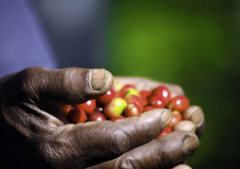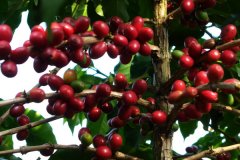Introduction of Guatemalan coffee beans with full grains and delicious balance
Cafe) controls the rest of the coffee industry. Some of Guatemala's finest coffee is exported to Japan, where it sells for $3 to $4 a cup. Most of the small-scale producers are descendants of Mayans, who like to be called natives. Currently, they are also benefiting from a U.S. -funded program known locally as "The Project."
Project), which plans to invest $2.5 million to encourage small, high-quality coffee plantations. The main area of Guatemala producing high quality coffee is Lake Atitlan
Atitlan) and Huehuentenango. The aim of the project is to help break the vicious cycle of high production and low quality that has plagued the world coffee industry. Bourbon trees, for example, grow taller and produce fewer beans than the new dwarf trees, and although they are both Arabica varieties, Bourbon trees produce better beans and are more popular with foodies. The project also hopes to encourage local producers to process coffee beans themselves, since most coffee cherries are now sold to middlemen, and the value and even quality of coffee could be improved if it could be processed in local factories.
Antigua is also a famous coffee producer. Antigua coffee is grown at Hacienda
Carmona), where the best quality coffee is Elpka (EL)
Pulcal) It is not only of good quality, but also has a stronger flavor, richer taste and stronger tobacco flavor than other coffees in Guatemala. Every 30 years or so, the area around Antigua is hit by a volcanic eruption, which provides more nitrogen to the already fertile land, and sufficient rainfall and sunshine make the area more suitable for growing coffee. Other coffee producing areas include San Marco.
Marco, Oriente & Cobain
Coban, Palcya, Mataquescuintia and La Mancha in Zacapa
Uman) and so on. The establishment of the Specialty Coffee Association means that Guatemala's government is beginning to pay attention to high-quality coffee, and the efforts to do so will soon pay off. The extra hard coffee beans here are full, delicious and balanced, and the coffee made with them is pure and rich. Guatemala coffee once enjoyed a reputation as the best coffee in the world, but the quality has also declined. Happily, however, its popularity is gradually being restored.
In 1750, Father Jesuit introduced coffee trees to Guatemala, where German colonists developed the coffee industry in the late 19th century. Today, most of the coffee industry is produced in the south of the country. Here, Sierra Madre
The slopes of the volcano provide ideal conditions for growing fine coffee beans, and coffee grown at high altitudes is vibrant. Critics prefer this blend of flavoured coffee with a spicy flavour to other types of coffee. The extra-hard coffee beans here are rare good coffee, it is full of particles, delicious, balanced acidity. Guatemala has also received attention for its giant coffee beans. The coffee industry, which once prospered the country, still dominates the national economy. Unfortunately, however, the political situation at home is not conducive to coffee growers. High output is usually a sign of overall economic prosperity in a country. However, coffee production in Guatemala has now declined relatively, to only 700 kg/ha, compared with 900 kg/ha in El Salvador and a staggering 1700 kg/ha in Costa Rica. Guatemala coffee export trade is controlled by private companies, but the National Coffee Commission

Important Notice :
前街咖啡 FrontStreet Coffee has moved to new addredd:
FrontStreet Coffee Address: 315,Donghua East Road,GuangZhou
Tel:020 38364473
- Prev

Tanzania Coffee Kilimanjaro Mountains (Mt.kilimanjaro) and Meru Mountains (Mt.
Tanzania (Tanzania) aroma 3.5 minutes brightness 4.5 minutes mellow 3 minutes flavor 4.5 minutes aftertaste 4.5 minutes suitable for baking: Full city/Expresso coffee beans in Tanzania can be roasted deeper, there is no problem before and after the second explosion, if roasting round beans (Peaberry) should be especially careful, because of the shape, it is easy to heat up too fast and exceed the scheduled temperature.
- Next

The famous producing area of Peruvian coffee is Chanchamayo, the mellow American coffee.
The global trend of modern coffee has gone through three popular stages: the first stage is the popularity of cheap coffee represented by instant coffee from the post-World War II to the 1960s; the second stage is the popularity of commercial coffee represented by Starbucks from the 1960s to the beginning of this century; the third stage is the popularity of boutique coffee, which originated in the 1970s and has become a trend in the past decade.
Related
- Does Rose Summer choose Blue, Green or Red? Detailed explanation of Rose Summer Coffee plots and Classification in Panamanian Jade Manor
- What is the difference between the origin, producing area, processing plant, cooperative and manor of coffee beans?
- How fine does the espresso powder fit? how to grind the espresso?
- Sca coffee roasting degree color card coffee roasting degree 8 roasting color values what do you mean?
- The practice of lattes: how to make lattes at home
- Introduction to Indonesian Fine Coffee beans-- Java Coffee producing area of Indonesian Arabica Coffee
- How much will the flavor of light and medium roasted rose summer be expressed? What baking level is rose summer suitable for?
- Introduction to the characteristics of washing, sun-drying or wet-planing coffee commonly used in Mantenin, Indonesia
- Price characteristics of Arabica Coffee Bean Starbucks introduction to Manning Coffee Bean Taste producing area Variety Manor
- What is the authentic Yega flavor? What are the flavor characteristics of the really excellent Yejasuffi coffee beans?

